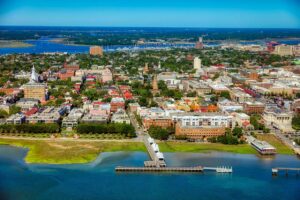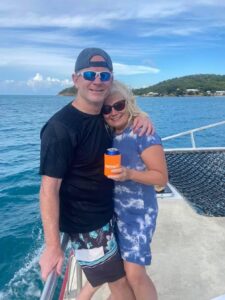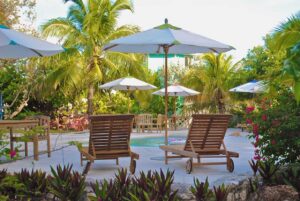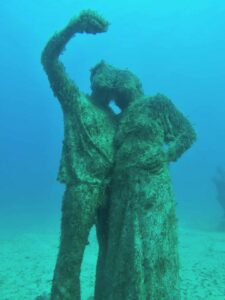How did an East Coast couple and their Down East lobster boat find their way from the Atlantic seaboard to Alaska The answer: When you dream big and don’t let anything get in your way, amazing things happen.
This particular dream was 20 years in the making, and the plan began to gel before we even took possession of our cruising yacht, Bee Weems, in 2006.
My husband, Peter, had been bitten by the Alaska bug 20 years earlier. He worked in Alaska when we lived in Seattle, and he had many friends who either fished professionally or cruised on their own pleasure yachts in southeast Alaska. Peter had traveled there on other people’s boats, but his dream was to do this on his own.
After two years familiarizing ourselves with our new boat on the East Coast, cruising from the Bahamas to Nova Scotia, we were ready to turn our sights toward Alaska. Due to busy careers, we only have two months available each year for cruising, so we had to plan carefully. Over the summer of 2008, we executed the first two-month stage, traveling from Annapolis, Maryland, to Duluth, Minnesota, by water — then Bee Weems was put on a truck and shipped to Anacortes, Washington.
The second stage involved a month’s vacation in the Broughton Archipelago in British Columbia the following summer. We outfitted Bee Weems with crab and shrimp pots and a good supply of food and departed from Anacortes, where Bee Weems had wintered in a comfortable covered slip. We gunk-holed for four weeks, exploring the rarely visited islands that hug the Canadian coastline and cruising among whales, dolphins and spawning salmon, hauling our full crab and shrimp pots aboard. Bee Weems maneuvered well in strong currents and deep waters. It was an excellent introduction to the third stage of our Alaska odyssey the following year: the wilderness experience of southeast Alaska.
By the time this two-month summer adventure rolled around, we had tapped into the knowledge base of all our friends and acquaintances who had ever cruised to southeast Alaska. They had shared lists of favorite anchorages, provisioning stops and secret crabbing and shrimping locations. We were like sponges, soaking up every bit of information we could glean. We acquired all the charts and cruising books, all the necessary equipment, clothing and boots.
Our plan was to take two weeks to travel to Ketchikan, Alaska, from Anacortes. Weather is always the number one concern for any cruise, and we were fortunate that the weather was good for our mid-June departure. The trip north involved crossing wide-open straits and ducking into pristine anchorages among the many islands. We planned out stops for fuel, water, provisions, and garbage removal in the sparsely located towns along the way.
When we crossed into Alaskan waters from Canada, we were greeted by a convocation of bald eagles on two rocky outcrops on either side of Bee Weems. I had never seen so many eagles in one place before. They were a harbinger of what was to come over the next weeks.
Southeast Alaska was designated a national forest more than 100 years ago by President Theodore Roosevelt. Tongass National Forest is 16.9 million acres, the largest in the United States. The entire region is a coastal temperate rainforest, which means it receives more than 55 inches of precipitation annually. Approximately 75,000 people live in 31 communities, the largest of which is Juneau, Alaska’s capital, with a population of 31,000. It’s impossible to convey the immensity and majesty of this vast land of giant timbers, glaciers and snow-covered peaks. It is very possible, however, to spend several weeks here without catching a glimpse of a mountain due to cloud cover and rain. Either way, the opportunities to observe the spectacular wildlife are exceptional.
Peter and I each had a pair of top-quality Weems & Plath binoculars. We often diverted course to follow the wildlife. We learned very quickly to scan the shoreline for bears, wolves and moose. We listened to the radio for chatter about whale activity. We watched humpback whales bubble feed and heard their eerie dinosaur-like calls. We saw bears turn over beach rocks in search of crabs and watched four bears feeding off a dead whale at the same time.
There are no preset itineraries for Alaska cruising adventures. Ketchikan, Juneau and Sitka are the three major provisioning towns with airports. We docked at Eliason Harbor (907-747-3439, cityofsitka.com) in the city of Sitka, which has Russian ties and an onion-domed Russian Orthodox church sitting in the midst of it. Most other stops are native villages or old fishing or logging camps with minimum services.
Our method of cruising in Alaska was always to pay attention to weather first. We didn’t attempt open-water crossings in high-wind situations but usually moved every day because there are so many amazing coves, inlets and bays to explore. We timed our visits to villages and towns only when we were in need of fuel and provisions. The rest of the time we anchored in solitude or with only one or two other boats. It might seem like a lonely experience, but even in this vast area, we repeatedly saw the same boats and began communicating with them on the VHF radio and then inviting one aboard for cocktails. They’ve developed into lifelong friends.
Most boats are in Alaska to harvest the bounty of the sea, and most folks on boats are commercial, charter or sport fishermen. Even the pleasure boaters spend much of their cruising time fishing, crabbing and shrimping. Peter and I didn’t have all the correct fishing gear on board and Bee Weems doesn’t go slowly enough to troll, but even if we were able to catch fish, we didn’t have the freezer space for storing it once it was caught. We were, however, the benefactors of several gifts of salmon, halibut and shrimp from boating friends along the way.
There are two sites that almost all cruisers visit in southeast Alaska. The first is Anan Creek Wildlife Observatory, and the second is Glacier Bay National Park. Anan Creek Wildlife Observatory is set next to a river where salmon spawn from June to September, and the black bear come to feast on them. The National Forest Service operates this park, and at high season visitors must call ahead to make reservations and pay a fee. When we arrived, we anchored in the bay, took the dinghy to shore and walked the mile-long boardwalk to the observatory situated next to a waterfall. I was a bit nervous because I’d observed fresh bear scat along the path and bear claw marks in the wet dirt, which reminded me that we were not in the safety of a zoo. Soon after we arrived at the observation area, a bear sauntered up the boardwalk behind us. The observation area is enclosed and safe from bears, but it was still a little disconcerting to see a bear show up so soon after our arrival. We spent an amazing hour watching the bears feed on the salmon.
By the end of our adventure, we knew more about the three types of Alaskan bears than we ever had expected to learn. The Alaskan brown bear is essentially the same as the grizzly bear, but bigger. Both grizzly and brown bears have humps, whereas black bears are humpless and are much smaller and less aggressive — or so we were told. We took seriously the advice we’d gotten to carry noise makers for scaring away bears if they approached us while we were exploring the shore. And although it was tempting to venture out on long hikes to stretch our legs after days on the boat in tight quarters, we did very little hiking in order to avoid any possible bear confrontations.
Our favorite cruising area, without a doubt, was Glacier Bay National Park. This national treasure is as spectacular as the Grand Canyon, except that instead of looking down at the amazing scenery, you look up at it. Even though it is hundreds of miles from civilization, the park is visited by many thousands of people who arrive every day via cruise ship, charter boats and commercial aircraft. Because of the popularity of Glacier Bay, we made reservations months in advance at Glacier Bay National Park’s marina facility in Bartlett Cove (907-697-2627). We enjoyed a full week there, attending talks given by park rangers and a tour boat trip before venturing into the bay ourselves. There are several glaciers in the park. In the 1700s, Captain Cook would have seen just one glacier, many miles long. Now, due to global warming, that one glacier has receded into more than five smaller ones. We were able to bring Bee Weems very close to the face of the glaciers, but stayed clear of any possible collisions with calving ice. Maneuvering among “bergy bits” — small chunks of ice that have broken free of the glacier face — was a first for us and not an experience for the faint of heart.
Our journey to Alaska was both challenging and spectacularly rewarding. It was well worth the 20-year wait. We hope this story inspires you to go forth and follow your cruising dreams, wherever they may take you.





